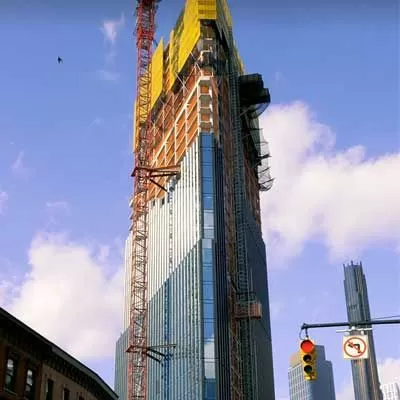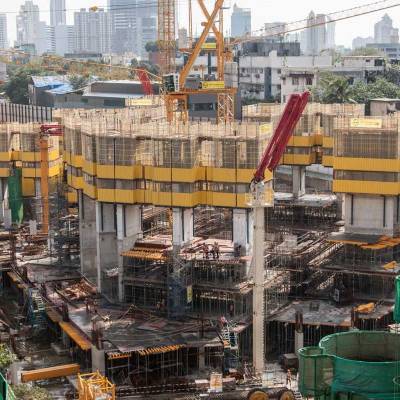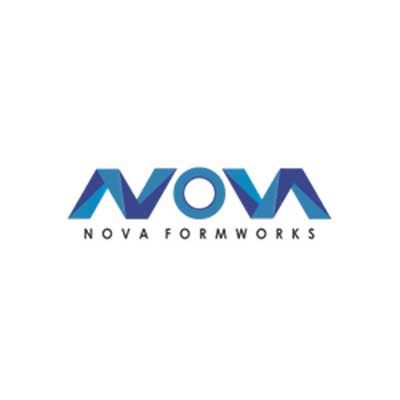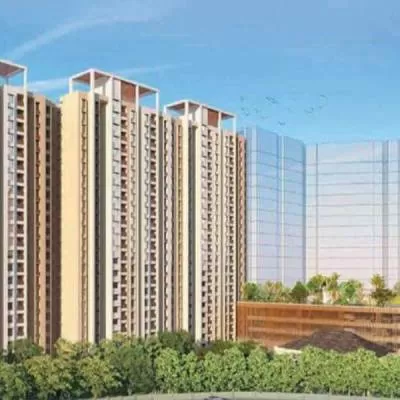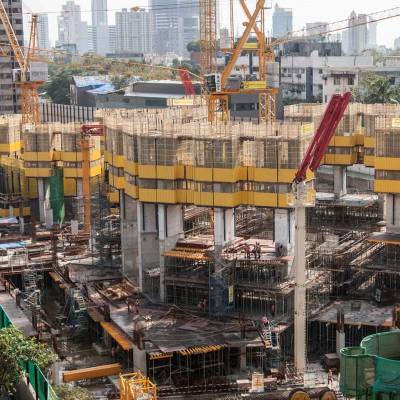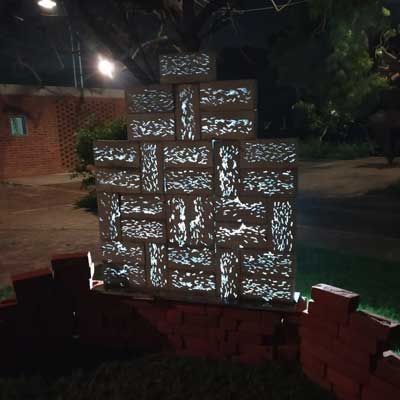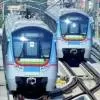- Home
- Real Estate
- In Form
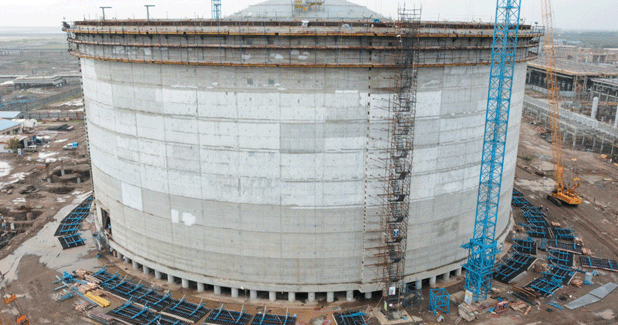
In Form
With input costs of labour and material rising exponentially and the latter being relatively fixed, contractors are turning to mechanisation to contain labour costs. In this scenario, modern formwork technologies, typically lightweight aluminium formwork, can greatly facilitate accelerated and economical construction.
¨Lightweight aluminium formwork can easily be assembled and disassembled manually and has a faster reuse capacity,¨ notes Shreeniwas Kelkar, Country Product & Marketing Manager, Doka India. ¨It is better suited to structures with a repetitive design, typically residential structures where it can be reused many times over through the construction cycle. Also, it helps eliminate the need for external plastering.¨
Contractors aware of the advantages of aluminium formwork systems, are investing in them despite the cost.
¨We´re seeing the greater adoption of new technologies for fast construction, where the labour component is reduced,¨ opines Sharad Rastogi, Director, Scaff India.
Tunnel forms
One of the most prominent trends in formwork is the increasing use of aluminium formwork systems, also called tunnel formwork, for monolithic construction. It is well suited to buildings with repetitive units of standard sizes and modules.
¨Adoption of monolithic construction aluminium formwork systems has picked up tremendously in the past four to five years, mostly because it is lightweight (vis-a-vis steel formwork systems) and can be tailor-made to allow single monolith casting, walls, columns, beams and slab in one pour, in turn, reducing construction time and costs with no compromise on concrete finish,¨ says Hari Om, Director, BSL Scaffolding Ltd.
To cater to this trend, Scaff India has introduced Neru tunnel formwork, a system from the Neru Formwork Company of Turkey. ¨Neru formwork is ideal for the fast construction of mass-housing projects. It allows contractors to complete the sequence of assembly of shuttering, laying of reinforcement, providing services, concreting, curing and de-shuttering in 24 to 48 hours, thereby casting a floor everyday or every second day,¨ explains Rastogi. All this is achieved with half the manpower required for conventional modular systems such as Miwan, he adds. BSL Scaffolding has introduced the Turkish Dema tunnel form system. ¨In projects with a floor plan of 200 to 350 sq m, tunnel form work can help contractors achieve 20 to 25 floor pours a month, provided the structural design conforms to the use of tunnel formwork,¨ says Om. Other advantages of Dema tunnel form work are that it needs, at most, a crane of 8 tonne capacity, thus saving on crane costs, and can be reused up to 1,000 times.
Doka´s OneGo formwork system is compact and lightweight enough to need only a few form-tie points and floor props. It features synchronised forming and stripping processes, integrated stripping aids such as a stripping head for floor-slab formwork and chamfered panel joints. The formwork can be reused immediately. It adapts to the most varied ground plan shapes.
Pushing adoption
Omkar Realtors & Developers has used the latest Turkish technology successfully in rehab projects at VGS Goregoan and Worli in Mumbai. ¨It creates a monolithic structure that is more stable and sturdier than conventional structures,¨ opines Rajendra Varma, Director, Omkar Realtors & Developers. ¨It also cuts a two-stage operation into a single operation by eliminating the block work that happens after a slab is cast.¨
All-round advantages ensue from Turkish technology. ¨We´ve saved on skilled labour costs and delivered the project faster, which is so important for slum dwellers who incur transit rent while their rehab houses are under construction,¨ adds Varma. ¨This technology is better for mid-high rise towers.¨
However, still too few companies are making use of tunnel forms. According to Om, ¨Indian developers are still not giving architects and structural designers clear guidelines to design as per the needs; this construction technology would help complete projects faster. Greater developer interest is essential to push adoption of tunnel formwork.¨
To further the adoption of tunnel form technology, Scaff India is offering package services including consultancy with Turkish experts and negotiations with Turkish construction companies for the construction of the shell structure.
Jump forms
Jump form systems, also called climbing forms, are composed of formwork and working platforms. Jump form systems are designed for the construction of vertical concrete elements in high-rise structures, such as core walls, lift shafts, stair shafts and bridge piers. As the construction rises, the system climbs with support from the concrete already cast.
Jump form systems for medium-rise buildings are relocated with cranes. However, truly self-climbing systems climb on rails on the building and eliminate the need for cranes. These are typically used for structures of 20 storeys and above.
¨Jump form systems have enabled us to break the construction sequence in our ultra luxury Omkar 1973 project in Worli and luxury project Omkar Altamount in Malad,¨ shares Varma. ¨Instead of taking up the entire floor plate in one go, which would have been challenging because it is huge in view of the units being for the ultra luxury and luxury segments, we first constructed the core of the building and the columns, which bear the maximum load. Then, we took up the slab. Construction went much faster. Jump form systems are better suited for super high-rise towers.¨
Steel formwork
While aluminium formwork is predominantly preferred in real estate work, steel formwork is mandated for infra projects where the forms must bear the weight of heavy concrete structures and still offer repeated use. Power plants, cooling towers and chimneys are some such structures.
¨Infra projects have huge concrete pressures for which aluminium is not suitable,¨ says Sushil Sahani, Managing Director, Pranav Construction Systems Pvt Ltd. ¨Safety and security also take precedence at infra project sites. Steel formwork is best for infrastructure projects. We offer designed in Germany, made in India, Euro-compliant formwork with a lifespan of one project or up to 10 years, and up to 1,000 repetitive uses.¨
Stay-in-place formwork
Stay-in-place formwork becomes part of the structure under construction. As such, it eliminates the time and cost involved in de-shuttering. Coffor Construction Technology India brings patented European stay-in-place steel formwork technology to India.
¨Coffor formwork can be used to build monolithic load-bearing structures, which are safer during earthquakes.¨ says Hiral Patel, CEO, Coffor Construction Technology India.
¨It can be used to construct any vertical RCC wall, in residential (villas, row houses, up to G+4), commercial, industrial (ETP tanks, etc), and infrastructure projects (storm-water drains, etc). Using Coffor, many of today´s site-related challenges can be alleviated - such as labour shortages and long construction time cycles. Coffor is cost-effective in certain applications, however it is quicker in nearly all applications, which leads to total project cost savings owing to reduced overheads.¨ Coffor formwork is composed of two filtering grids made of rib lathe reinforced by vertical stiffeners. Articulated rebar loops and connectors join the grids. Europe´s Eurocode describes that Coffor wall structures act as ´lightly reinforced walls´ needing only minimum steel reinforcement for tie beams at each level, vertical tie beams at the intersection of walls and for door and windows. Jignesh Pawar, General Manager, Coffor Construction Technology India, estimates that Coffor forms cut the need for structural steel by 30 to 40 per cent where the system is fully utilised as a load-bearing structure. A unique feature of Coffor is that its in-built system for the elimination of excess water lowers the concrete water to cement ratio, which improves concrete quality.
Lubi Pumps opted to use Coffor forms to speed up the construction of a new project. ¨We used Coffor panels for the retaining wall of a basement. The construction was completed much quicker. It also helped us work with less labour, which was important because the project had gotten underway during a season when labour is in short supply,¨ shares Rohan Amin, Director, Lubi Pumps. ¨We propose to use Coffor panels for our upcoming projects where, again, speed of construction is critical.¨ Other kinds of stay-in-place forms are available overseas. One such system is made of recycled polypropylene and designed to create lightened slabs. Another is made of multiple layers of extremely stable webs of paper and carton, and designed to create round or rectangular columns. Such use-and-throw formwork is expensive and hence used sparsely for decorative columns for offices and commercial buildings needing fair finish, according to Sahani.
¨Use-and-throw or stay-in-place formwork is associated with faster cycle times,¨ observes Kelkar. ¨However, it is more expensive and increases overall construction costs despite lower finishing cost and ushering in savings on structural steel.¨
Evidently, greater awareness about new kinds of formwork and the advantages of each is sure to grow the market.
Quick Bytes
- Contractors in India are turning to mechanisation to contain labour costs.
- Increased use of aluminium formwork systems or tunnel formwork for monolithic construction is a trend.
- For 20 storeys and above: Self-climbing systems eliminate the need for cranes.
Factors that affect choice of formwork
Several factors affect the selection of formwork, says Shreeniwas Kelkar, Country Product & Marketing Manager, Doka India:
- The structural designer´s choice: Formwork design greatly affects cost, especially stay-in-place Coffor formwork that is made up of steel profiles and cuts the need for structural steel. To some extent, the structural designer can also affect the cost of aluminium formwork systems needed for a building and, in the process, make the individual units (residences or offices) more appealing to buyers by reducing the number of load-bearing walls and introducing non load-bearing walls amenable to alternations.
- The effectiveness of labour: The effectiveness of labour depends greatly on the supervision skills and the quality of daily planning. Overall, system formwork always saves labour cost over conventional formwork.
- The number of formwork reuses expected - the contractor´s choice: What kind of surface finish does the contractor expect from the formwork? How effectively is the formwork intended to be used? Is it expected to lower cycle times? What quality of plywood is used in the formwork? Will the formwork be maintained well?
- The architectural choice: What shape will the final structure take? Complex building shapes need extra consideration (care, detailing, etc).
Use formwork to eliminate plastering costs
¨Tunnel formwork eliminates the need for plastering,¨ opines Hari Om, Director, BSL Scaffolding Ltd. ¨Table formwork involving the use of film-faced plywood on tabletop is also a major time and labour saver, especially in construction projects with regular plan layouts or long repetitive structures. By delivering a fair concrete finish, it reduces the cost of plastering. Wall formwork system can also deliver fair-faced concrete finishes.¨
¨Eliminating the need for plastering is an add-on advantage of modern formwork,¨ says Rajendra Varma, Director, Omkar Realtors & Developers.
- Formwork
- Accelerate Construction
- Aluminium
- Shreeniwas Kelkar
- Doka India
- Sharad Rastogi
- Scaff India
- Hari Om
- BSL Scaffolding Ltd
- Neru Tunnel Formwork
- Mass-Housing Projects
- Miwan
- Turkish Dema
- Omkar Realtors & Developers
- Rehab Projects
- VGS Goregoan
- Rajendra Varma
- Luxury Project
- Real Estate
- Infra Projects
- Sushil Sahani
- Pranav Construction Systems Pvt Ltd
- Hiral Patel
- Coffor Constr
Choosing fit-for-purpose formwork can accelerate construction. With input costs of labour and material rising exponentially and the latter being relatively fixed, contractors are turning to mechanisation to contain labour costs. In this scenario, modern formwork technologies, typically lightweight aluminium formwork, can greatly facilitate accelerated and economical construction. ¨Lightweight aluminium formwork can easily be assembled and disassembled manually and has a faster reuse capacity,¨ notes Shreeniwas Kelkar, Country Product & Marketing Manager, Doka India. ¨It is better suited to structures with a repetitive design, typically residential structures where it can be reused many times over through the construction cycle. Also, it helps eliminate the need for external plastering.¨ Contractors aware of the advantages of aluminium formwork systems, are investing in them despite the cost. ¨We´re seeing the greater adoption of new technologies for fast construction, where the labour component is reduced,¨ opines Sharad Rastogi, Director, Scaff India. Tunnel forms One of the most prominent trends in formwork is the increasing use of aluminium formwork systems, also called tunnel formwork, for monolithic construction. It is well suited to buildings with repetitive units of standard sizes and modules. ¨Adoption of monolithic construction aluminium formwork systems has picked up tremendously in the past four to five years, mostly because it is lightweight (vis-a-vis steel formwork systems) and can be tailor-made to allow single monolith casting, walls, columns, beams and slab in one pour, in turn, reducing construction time and costs with no compromise on concrete finish,¨ says Hari Om, Director, BSL Scaffolding Ltd. To cater to this trend, Scaff India has introduced Neru tunnel formwork, a system from the Neru Formwork Company of Turkey. ¨Neru formwork is ideal for the fast construction of mass-housing projects. It allows contractors to complete the sequence of assembly of shuttering, laying of reinforcement, providing services, concreting, curing and de-shuttering in 24 to 48 hours, thereby casting a floor everyday or every second day,¨ explains Rastogi. All this is achieved with half the manpower required for conventional modular systems such as Miwan, he adds. BSL Scaffolding has introduced the Turkish Dema tunnel form system. ¨In projects with a floor plan of 200 to 350 sq m, tunnel form work can help contractors achieve 20 to 25 floor pours a month, provided the structural design conforms to the use of tunnel formwork,¨ says Om. Other advantages of Dema tunnel form work are that it needs, at most, a crane of 8 tonne capacity, thus saving on crane costs, and can be reused up to 1,000 times. Doka´s OneGo formwork system is compact and lightweight enough to need only a few form-tie points and floor props. It features synchronised forming and stripping processes, integrated stripping aids such as a stripping head for floor-slab formwork and chamfered panel joints. The formwork can be reused immediately. It adapts to the most varied ground plan shapes. Pushing adoption Omkar Realtors & Developers has used the latest Turkish technology successfully in rehab projects at VGS Goregoan and Worli in Mumbai. ¨It creates a monolithic structure that is more stable and sturdier than conventional structures,¨ opines Rajendra Varma, Director, Omkar Realtors & Developers. ¨It also cuts a two-stage operation into a single operation by eliminating the block work that happens after a slab is cast.¨ All-round advantages ensue from Turkish technology. ¨We´ve saved on skilled labour costs and delivered the project faster, which is so important for slum dwellers who incur transit rent while their rehab houses are under construction,¨ adds Varma. ¨This technology is better for mid-high rise towers.¨ However, still too few companies are making use of tunnel forms. According to Om, ¨Indian developers are still not giving architects and structural designers clear guidelines to design as per the needs; this construction technology would help complete projects faster. Greater developer interest is essential to push adoption of tunnel formwork.¨ To further the adoption of tunnel form technology, Scaff India is offering package services including consultancy with Turkish experts and negotiations with Turkish construction companies for the construction of the shell structure. Jump forms Jump form systems, also called climbing forms, are composed of formwork and working platforms. Jump form systems are designed for the construction of vertical concrete elements in high-rise structures, such as core walls, lift shafts, stair shafts and bridge piers. As the construction rises, the system climbs with support from the concrete already cast. Jump form systems for medium-rise buildings are relocated with cranes. However, truly self-climbing systems climb on rails on the building and eliminate the need for cranes. These are typically used for structures of 20 storeys and above. ¨Jump form systems have enabled us to break the construction sequence in our ultra luxury Omkar 1973 project in Worli and luxury project Omkar Altamount in Malad,¨ shares Varma. ¨Instead of taking up the entire floor plate in one go, which would have been challenging because it is huge in view of the units being for the ultra luxury and luxury segments, we first constructed the core of the building and the columns, which bear the maximum load. Then, we took up the slab. Construction went much faster. Jump form systems are better suited for super high-rise towers.¨ Steel formwork While aluminium formwork is predominantly preferred in real estate work, steel formwork is mandated for infra projects where the forms must bear the weight of heavy concrete structures and still offer repeated use. Power plants, cooling towers and chimneys are some such structures. ¨Infra projects have huge concrete pressures for which aluminium is not suitable,¨ says Sushil Sahani, Managing Director, Pranav Construction Systems Pvt Ltd. ¨Safety and security also take precedence at infra project sites. Steel formwork is best for infrastructure projects. We offer designed in Germany, made in India, Euro-compliant formwork with a lifespan of one project or up to 10 years, and up to 1,000 repetitive uses.¨ Stay-in-place formwork Stay-in-place formwork becomes part of the structure under construction. As such, it eliminates the time and cost involved in de-shuttering. Coffor Construction Technology India brings patented European stay-in-place steel formwork technology to India. ¨Coffor formwork can be used to build monolithic load-bearing structures, which are safer during earthquakes.¨ says Hiral Patel, CEO, Coffor Construction Technology India. ¨It can be used to construct any vertical RCC wall, in residential (villas, row houses, up to G+4), commercial, industrial (ETP tanks, etc), and infrastructure projects (storm-water drains, etc). Using Coffor, many of today´s site-related challenges can be alleviated - such as labour shortages and long construction time cycles. Coffor is cost-effective in certain applications, however it is quicker in nearly all applications, which leads to total project cost savings owing to reduced overheads.¨ Coffor formwork is composed of two filtering grids made of rib lathe reinforced by vertical stiffeners. Articulated rebar loops and connectors join the grids. Europe´s Eurocode describes that Coffor wall structures act as ´lightly reinforced walls´ needing only minimum steel reinforcement for tie beams at each level, vertical tie beams at the intersection of walls and for door and windows. Jignesh Pawar, General Manager, Coffor Construction Technology India, estimates that Coffor forms cut the need for structural steel by 30 to 40 per cent where the system is fully utilised as a load-bearing structure. A unique feature of Coffor is that its in-built system for the elimination of excess water lowers the concrete water to cement ratio, which improves concrete quality. Lubi Pumps opted to use Coffor forms to speed up the construction of a new project. ¨We used Coffor panels for the retaining wall of a basement. The construction was completed much quicker. It also helped us work with less labour, which was important because the project had gotten underway during a season when labour is in short supply,¨ shares Rohan Amin, Director, Lubi Pumps. ¨We propose to use Coffor panels for our upcoming projects where, again, speed of construction is critical.¨ Other kinds of stay-in-place forms are available overseas. One such system is made of recycled polypropylene and designed to create lightened slabs. Another is made of multiple layers of extremely stable webs of paper and carton, and designed to create round or rectangular columns. Such use-and-throw formwork is expensive and hence used sparsely for decorative columns for offices and commercial buildings needing fair finish, according to Sahani. ¨Use-and-throw or stay-in-place formwork is associated with faster cycle times,¨ observes Kelkar. ¨However, it is more expensive and increases overall construction costs despite lower finishing cost and ushering in savings on structural steel.¨ Evidently, greater awareness about new kinds of formwork and the advantages of each is sure to grow the market. Quick Bytes Contractors in India are turning to mechanisation to contain labour costs. Increased use of aluminium formwork systems or tunnel formwork for monolithic construction is a trend. For 20 storeys and above: Self-climbing systems eliminate the need for cranes. Factors that affect choice of formwork Several factors affect the selection of formwork, says Shreeniwas Kelkar, Country Product & Marketing Manager, Doka India: The structural designer´s choice: Formwork design greatly affects cost, especially stay-in-place Coffor formwork that is made up of steel profiles and cuts the need for structural steel. To some extent, the structural designer can also affect the cost of aluminium formwork systems needed for a building and, in the process, make the individual units (residences or offices) more appealing to buyers by reducing the number of load-bearing walls and introducing non load-bearing walls amenable to alternations. The effectiveness of labour: The effectiveness of labour depends greatly on the supervision skills and the quality of daily planning. Overall, system formwork always saves labour cost over conventional formwork. The number of formwork reuses expected - the contractor´s choice: What kind of surface finish does the contractor expect from the formwork? How effectively is the formwork intended to be used? Is it expected to lower cycle times? What quality of plywood is used in the formwork? Will the formwork be maintained well? The architectural choice: What shape will the final structure take? Complex building shapes need extra consideration (care, detailing, etc). Use formwork to eliminate plastering costs ¨Tunnel formwork eliminates the need for plastering,¨ opines Hari Om, Director, BSL Scaffolding Ltd. ¨Table formwork involving the use of film-faced plywood on tabletop is also a major time and labour saver, especially in construction projects with regular plan layouts or long repetitive structures. By delivering a fair concrete finish, it reduces the cost of plastering. Wall formwork system can also deliver fair-faced concrete finishes.¨ ¨Eliminating the need for plastering is an add-on advantage of modern formwork,¨ says Rajendra Varma, Director, Omkar Realtors & Developers.


